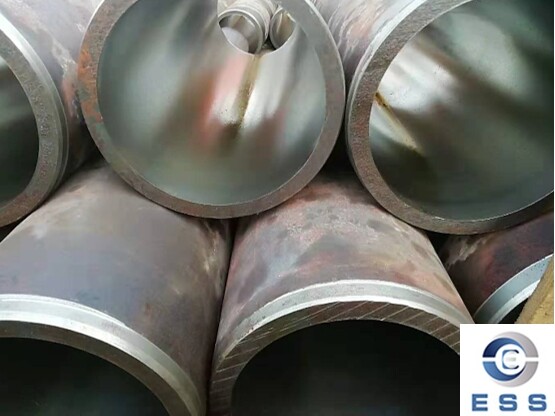Seamless
steel pipe, as an indispensable material in the modern industrial field,
have a vital impact on the safety and stability of various engineering projects
due to their quality and performance. However, various defects often occur
during the production and use of seamless steel pipes. These defects not only
affect the performance of the steel pipes, but may also threaten the safety of
engineering projects. Therefore, understanding the defect characteristics and
causes of seamless steel pipes is of great significance for improving the
quality and use of seamless steel pipes.

Main defects of seamless steel pipes
1. Cracks
Cracks are one of the most common defects
of seamless steel pipes, which manifest as straight or spiral cracks on the
inner and outer surfaces of the steel pipe. The two ends and bottom of the
cracks are often sharp and may be distributed in a mesh. There are many reasons
for the occurrence of cracks, mainly including poor steel quality, improper
heating of the pipe blank, and excessive deformation pressure.
2. Hair-like fine lines
Hairline is a continuous or discontinuous
hair-like fine line on the outer surface of the seamless steel pipe, mostly
spiral, and the spiral direction is opposite to the rotation direction of the
puncher. The causes of hairline are similar to those of cracks, mainly related
to factors such as poor steel quality and incomplete cleaning of the tube
surface.
3. Internal folding
Internal folding refers to the straight or
spiral serrated defects on the inner surface of the steel pipe. For high-alloy
steel pipes, this defect may appear in irregular blocks and be distributed at
the inlet. The main causes of internal folding include excessive front pressure
of the plug, severe wear of the plug, and strong alternating stress on the
metal in the center of the billet during the piercing process.
4. External folding
External folding is manifested as spiral
folding on the outer surface of the seamless steel pipe, and its spiral
direction is opposite to the spiral direction of the rough pipe on the piercing
machine. The main causes of external folding include defects such as cracks or
ears remaining on the surface of the tube billet, poor steel quality, etc.
5. Rolling folding
Rolling folding is a regular folding defect
on the outer surface of the seamless steel pipe, which is mainly caused by
damage to the piercing machine roll or the tube rolling mill roll.
6. Tie-off
Tie-off is the bending caused by metal
entering the gap between the rollers or the loss of stability of the tube
during rolling. After sizing, it appears as local convex and concave wrinkles
on the surface of the steel tube. The main reasons include that the outlet
diameter of the sizing machine is larger than the hole type of the sizing
machine, incorrect adjustment, and roller misalignment.
Causes of seamless steel pipe defects
1. Raw materials
Poor internal structure and poor surface
quality of raw materials are important causes of seamless steel pipe defects.
Poor internal structure may cause defects such as internal folding, internal
cracks in the tube wall, and delamination; poor surface quality may cause
defects such as external folding.
2. Process operation
Improper process operation such as improper
heating, excessive deformation pressure, and incomplete cleaning of the tube
surface are also important causes of seamless steel pipe defects. Improper
heating may cause defects such as internal folding, external folding, and
internal cracks in the tube wall; excessive deformation pressure may cause
defects such as cracks.
3. Equipment
Poor equipment performance, looseness, and
scratches may also cause seamless steel pipe defects. For example, damage to
the piercing machine roll or the tube mill roll may lead to defects such as
rolling folding.
Prevention and control of seamless steel
pipe defects
In order to reduce the occurrence of
seamless steel pipe defects and improve the quality and use effect of seamless
steel pipes, the following measures need to be taken:
1. Strengthen raw material quality control
Strictly control the internal organization
and surface quality of raw materials, and select high-quality raw materials for
production.
2. Optimize process operation
Reasonably set process parameters such as
heating temperature and deformation pressure to ensure the stability and
accuracy of process operation. At the same time, strengthen the surface
cleaning of the tube billet to ensure the smoothness and flatness of the tube
billet surface.
3. Strengthen equipment maintenance and
management
Regularly inspect and maintain production
equipment to ensure the normal operation and stable performance of the
equipment. Damaged equipment parts should be replaced and repaired in time to
avoid equipment failures affecting the quality of seamless steel pipes.
4. Strengthen quality inspection and
monitoring
Establish a complete quality inspection and
monitoring system to monitor and inspect the production process of seamless
steel pipes throughout the process. Defects found should be handled and
rectified in a timely manner to ensure that the quality of seamless steel pipes
meets the standard requirements.
Summary
In summary, the defect characteristics and
causes of seamless steel pipes are multifaceted, and comprehensive analysis and
control are required from the aspects of raw materials, process operation,
equipment, etc. By strengthening raw material quality control, optimizing
process operation, strengthening equipment maintenance and management, and
strengthening quality inspection and monitoring, the generation of seamless
steel pipe defects can be effectively reduced and the quality and use effect of
seamless steel pipes can be improved.
Read more: Seamless Steel Pipe Sizes













 Eastern Steel Manufacturing Co.,Ltd not only improve product production and sales services, but also provide additional value-added services. As long as you need, we can complete your specific needs together.
Eastern Steel Manufacturing Co.,Ltd not only improve product production and sales services, but also provide additional value-added services. As long as you need, we can complete your specific needs together.










